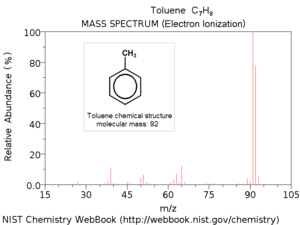Mass spectrum facts for kids
A mass spectrum is like a special picture or graph. It helps scientists understand what a sample is made of. Imagine you have a mystery mixture. A mass spectrum can show you all the different tiny pieces inside it. It plots how much of each piece there is, based on its weight and electric charge.
Contents
What is a Mass Spectrum?
A mass spectrum is a graph that shows the different parts of a chemical sample. It tells us how much of each part is present. This graph is usually made using a special machine called a mass spectrometer.
How Does a Mass Spectrometer Work?
A mass spectrometer breaks down the molecules in a sample into smaller, charged pieces called ions. Then, it measures the weight and electric charge of each ion. This information is then used to create the mass spectrum graph.
What Does the Graph Show?
The mass spectrum graph has two main parts:
- Mass-to-charge ratio (m/z): This is on the bottom (horizontal) axis. It tells us the weight of each ion compared to its electric charge.
- Intensity: This is on the side (vertical) axis. It shows how much of each ion was found. A taller peak means there was more of that specific ion.
Why Are Mass Spectra Useful?
Scientists use mass spectra for many reasons:
- Identifying chemicals: Each chemical has a unique mass spectrum, like a fingerprint. This helps scientists figure out what unknown substances are.
- Finding tiny amounts: Mass spectrometers are very sensitive. They can find even tiny amounts of chemicals in a sample.
- Studying molecules: Scientists can learn how molecules break apart. This helps them understand how chemicals react.
How Are Mass Spectra Interpreted?
In the past, only expert chemists could understand mass spectra. They had to carefully look at the peaks and figure out what each one meant. Today, special computer programs help a lot. These programs can quickly read the data. They can identify the chemicals in a sample much faster.
Images for kids
-
Mass spectrum of sodium and potassium positive ions from Arthur Jeffrey Dempster's 1918 publication "A new Method of Positive Ray Analysis " Phys. Rev. 11, 316 (1918)
See also
 In Spanish: Espectro de masas para niños
In Spanish: Espectro de masas para niños



